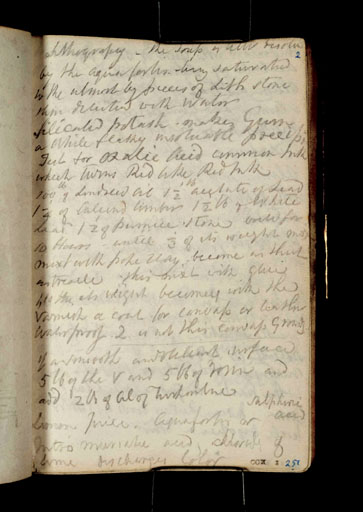Joseph Mallord William Turner Recipes for Lithographic Printing c.1824
Image 1 of 2
Joseph Mallord William Turner,
Recipes for Lithographic Printing
c.1824
Joseph Mallord William Turner 1775–1851
Folio 2 Recto:
Recipes for Lithographic Printing c.1824
D18313
Turner Bequest CCX 2
Turner Bequest CCX 2
Pencil on white wove paper, 118 x 75 mm
Inscribed in pencil by Turner with recipes for lithographic printing (transcribed in full in the main entry)
Inscribed in blue ink by Ruskin ‘2’ top right and ‘251’ bottom right
Stamped in black ‘CCX 2’ bottom right
Inscribed in pencil by Turner with recipes for lithographic printing (transcribed in full in the main entry)
Inscribed in blue ink by Ruskin ‘2’ top right and ‘251’ bottom right
Stamped in black ‘CCX 2’ bottom right
Accepted by the nation as part of the Turner Bequest 1856
References
1909
A.J. Finberg, A Complete Inventory of the Drawings of the Turner Bequest, London 1909, vol.II, p.634–5, CCX 2, ‘The following in pencil: – [with transcriptions]’.
1910
C[harles] Lewis Hind, Turner’s Golden Visions, London and Edinburgh 1910 and 1925, p.131.
1969
John Gage, Colour in Turner: Poetry and Truth, London 1969, pp.43, 233 note 126.
1992
Joyce H. Townsend, ‘Turner’s Writings on Chemistry and Artists’ Materials’, Turner Society News, no.62, December 1992, p.8.
Here Turner has inscribed a page of recipes for chemicals used in the processes of lithographic reproduction. 1 Lithography is a method of printing from a flat surface (such as a smooth stone or a metal plate) which has been prepared so that the image to be printed is ink-receptive and the blank areas are ink-repellent. The technique was invented by the German actor and playwright Alois Senefelder (1771–1834). Turner owned a copy of Senefelder’s A Complete Course of Lithography (1819), so it is likely that these notes were extracted from this source.2 Further notes on the chemical aspects of engraving and painting are found on Tate D18314–D18316; Turner Bequest CCX 2a–3a.
Turner’s notes are transcribed thus:
Turner’s notes are transcribed thus:
‘Lithography – the Soap is [...] desolv[ed]
by the Aqua fortis – being saturated
to the utmost by pieces of Lith stone
then diluted with Water.
Silicated potash makes Gum
a White flakey insoluble precipi[?tate]
Test for Oxalic Acid common Ink
which turns Red like Red Milk
100lb of Linseed Oil 1 ½ lb Acetate of Lead
1 ¼ of Calcined Umber 1 ½ lb of White
Lead. 1 ½ of pumice stone boild for
10 hours – until 1/3 of its weight and
mixt with pipe clay, becomes thick
as treacle. This mixt with glue
[...] to the oils weight becomes with the
Varnish a coat for canvass or leather
Waterproof. 2 is not this canvas ground.
_______________________________
by the Aqua fortis – being saturated
to the utmost by pieces of Lith stone
then diluted with Water.
Silicated potash makes Gum
a White flakey insoluble precipi[?tate]
Test for Oxalic Acid common Ink
which turns Red like Red Milk
100lb of Linseed Oil 1 ½ lb Acetate of Lead
1 ¼ of Calcined Umber 1 ½ lb of White
Lead. 1 ½ of pumice stone boild for
10 hours – until 1/3 of its weight and
mixt with pipe clay, becomes thick
as treacle. This mixt with glue
[...] to the oils weight becomes with the
Varnish a coat for canvass or leather
Waterproof. 2 is not this canvas ground.
_______________________________
If a smooth and brilliant surface
5 lb of the V and 5 lb of rosin and
add 2 lb of Oil of Turpentine
lemon Juice. Aquafortis or sulphuric acid
Intro muriatic acid, chloride of
lime discharges Color’.
5 lb of the V and 5 lb of rosin and
add 2 lb of Oil of Turpentine
lemon Juice. Aquafortis or sulphuric acid
Intro muriatic acid, chloride of
lime discharges Color’.
Alice Rylance-Watson
February 2015
How to cite
Alice Rylance-Watson, ‘Recipes for Lithographic Printing c.1824 by Joseph Mallord William Turner’, catalogue entry, February 2015, in David Blayney Brown (ed.), J.M.W. Turner: Sketchbooks, Drawings and Watercolours, Tate Research Publication, August 2016, https://www


